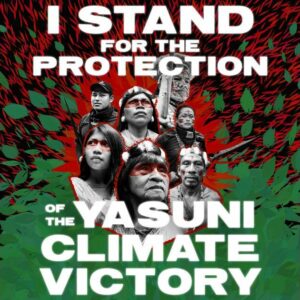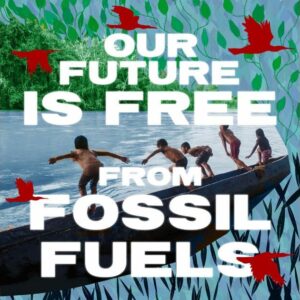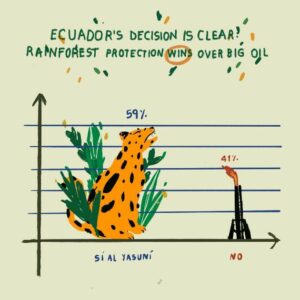Hundreds of Indigenous peoples from around the world traveled to Colombia to make their voices heard at this year’s United Nations biodiversity summit, COP16. Many arrived with mixed feelings of hope and worry. Would this COP be an opportunity for the recognition of their leadership and solutions to the biodiversity and climate crises? Would global leaders recognize Indigenous territories as a key form of conservation in their plans and funding to preserve 30% of the planet’s land, water, and marine areas by 2030?
The international conference took place at a pivotal moment as South America rises as a leader in climate and biodiversity policy. With Colombia’s President Petro hosting COP in Cali and Brazil set to host the G20 summit in Rio in November 2024 and the UN Climate Change COP30 in November 2025, the region’s leadership in climate action is increasingly prominent.
Over the past two years, the continent has been facing a record-breaking drought which has particularly affected the Amazon rainforest, where Indigenous peoples are facing intensifying violence and environmental destruction due to deforestation, mining, energy and infrastructure projects, and illicit economic activities. The illegal presence of armed groups in Indigenous territories has further escalated threats to the lives and well-being of Indigenous communities, placing them in jeopardy of both physical and cultural extermination.
At COP16, Colombia’s President Gustavo Petro and Minister of Environment and Sustainable Development Susana Muhamad delivered powerful speeches urging the world to recognize and make “peace with nature” as an essential step to halt environmental destruction and prevent ecocide. Many Indigenous leaders and climate activists resonated deeply with this message, finding common ground on the urgent need to decarbonize the global economy, end fossil fuel dependency, and transition to renewable energy sources. These steps are vital to avert irreversible tipping points and the full-scale destruction of earth’s most important biomes like the Amazon rainforest.
Hopes were therefore high for the COP16 to mark a turning point for the greater inclusion of voices from Indigenous territories. In past conferences, Indigenous perspectives have often been sidelined amid the hype, negotiations, and posturing associated with the COPs, reinforcing the event’s reputation as an elitist, exclusionary space with limited participation by Indigenous peoples and organizations. This exclusion is especially troubling when it comes to the Amazon, an ecosystem that governments and multilateral organizations claim to prioritize. Yet, despite this rhetoric, there has been minimal genuine interest in protecting and safeguarding the region or in truly understanding its vast significance. As Siona leader Mario Erazo Yaiguaje from the Putumayo River remarks, “The commitments of world leaders often go unfulfilled. We need promises to be turned into actions so that we can see real changes in our territories”.

Members of the COP16 delegation organized by Amazon Frontlines and Ceibo Alliance in Cali, Colombia. Photo: Amazon Frontlines / Ceibo Alliance
Our COP16 Delegation
Twenty-three Amazon Frontlines and Ceibo Alliance team members and Indigenous leaders from the A’i Cofán, Andwa, Siekopai, Siona, and Shuar Nations attended the COP16 to share and amplify their lived experiences, stories, and our work across the upper Amazon. Our voices joined others from around the Americas in drawing attention to threats emerging across the region driven by heads of government and growing extractive industry interests, and in calling for greater accountability to commitments made on behalf of protecting biodiversity in Latin America.
There was high anticipation for a new type of gathering space at the COP16 called the “Green Zone”, running parallel to the official “Blue Zone”. While the “Blue Zone” hosts closed-door discussions and decision-making by state delegates of 196 countries, the “Green Zone” was designed to bring together organizations, Indigenous representatives, communities, academics, and the general public. Here, participants engaged in open dialogue, strategizing to protect ecosystems, rivers, and mountains, while also exploring political agreements and commitments to ensure the cultural survival of Indigenous territories.
Our delegation organized a series of events in the blue and green zones to push participating countries to meet their commitment of protecting 30% of land and water by 2030 by ensuring Indigenous rights and autonomy are prioritized, and to advocate for the reform of national laws to reflect, protect, and actively support Indigenous stewardship:

Photo: Ribaldo Piaguaje
The situation of cross-border Indigenous peoples between Ecuador, Peru, and Colombia and the conservation of biodiversity (blue zone)
Indigenous communities living on the borders of Ecuador, Peru, and Colombia are facing immense challenges as they struggle to protect their lands and cultures from state neglect, extractivism, and organized crime. These artificial borders, drawn without considering ancestral territories, have fragmented Indigenous societies, disrupting their connection to their land and traditions and putting their survival at risk.
Featured speakers included: Mario Erazo Yaiguaje, Siona Leader of the Putumayo River; Justino Piaguage, Territory Leader of the Siekopai Nation (NASIEPAI), Edinson Sandoval, President of the Secoya Organization of Peru (OISPE); Wider Guaramag, President of the A’i Cofán Community of Sinangoe; Jenny Paguay, Governor of the A’i Cofán Reservation of Santa Rosa del Valle del Guamuez; Josefina Tunki, Shuar Leader, current Vice President of the Ticca Consortium of Latin America; Milton Callera, President of the Binational Coordinator of the Achuar Nation of Ecuador-Peru. The moderator was Alexandra Narváez, A’i Cofán leader, Indigenous Guard of Sinangoe & Goldman Prize Winner.

Photo: Ribaldo Piaguaje
Community Indigenous guards as a strategy to safeguard biodiversity (blue zone)
Indigenous and environmental defenders are crucial to the success of global efforts to protect biodiversity and sustain life. The recognition and support of community-based Indigenous Guards are vital not only for safeguarding territories but also for protecting the leaders and defenders who face tremendous risks in their work, including stigmatization, criminalization, violence, and even death. Latin America remains the most dangerous region in the world for defenders of rights and territories, with Colombia ranked as the deadliest country for these individuals.
Featured speakers included: Leonidas Iza, President of the Confederation of Indigenous Nations of Ecuador (CONAIE); Brigitte Escobar, Cuiracua of the Buenavista Reservation; Alexandra Narváez, A’i Cofán leader, Indigenous Guard of Sinangoe & Goldman Prize Winner; Lizardo Cauper, Coshikox, the Shipibo Conibo Cetebo Council; Evaristo Wajai, Wampis Nation; Robert Molina, member of the Indigenous Land Defense Committee (Punta de Lanza) of Ceibo Alliance & Amazon Frontlines and Indigenous Guard of the Kokonuko People; Hember Cucuñame, Coordinator of the Program for the Defense of Life and Human Rights of the Regional Indigenous Council of Cauca.

Photo: Luisana Aguilar
Conservation of the biological and cultural diversity of Pastaza, as an indicator to achieve the goals of the Global Framework on Biodiversity (blue zone) in the face of bidding for oil blocks in the southeastern area
Pastaza province in the Ecuadorian Amazon is the country’s most well-preserved rainforest, with 85% of its land designated as Indigenous territory, home to seven Indigenous nations: Andwa, Kichwa, Shuar, Achuar, Sapara, Shiwiar, and Waorani. However, many oil blocks designated by the government overlap with these Indigenous territories, posing a direct threat to the region’s rich biodiversity and the survival of its Indigenous peoples
Featured speakers included: Daniel Dagua, leader of the Andwa Nation; Luis Enqueri, Waorani leader (OWAP); Milton Calleras, President of the Binational Coordinator of the Achuar Nation of Ecuador-Peru (COBNAEP); María José Andrade, leader of CONFENIAE; Domingo Ankuash, Shuar leader and president of FICSH; and Javier Palummo, Rapporteur on Economic, Social, Cultural and Environmental Rights (ESCR) of the Inter-American Commission on Human Rights (IACHR).
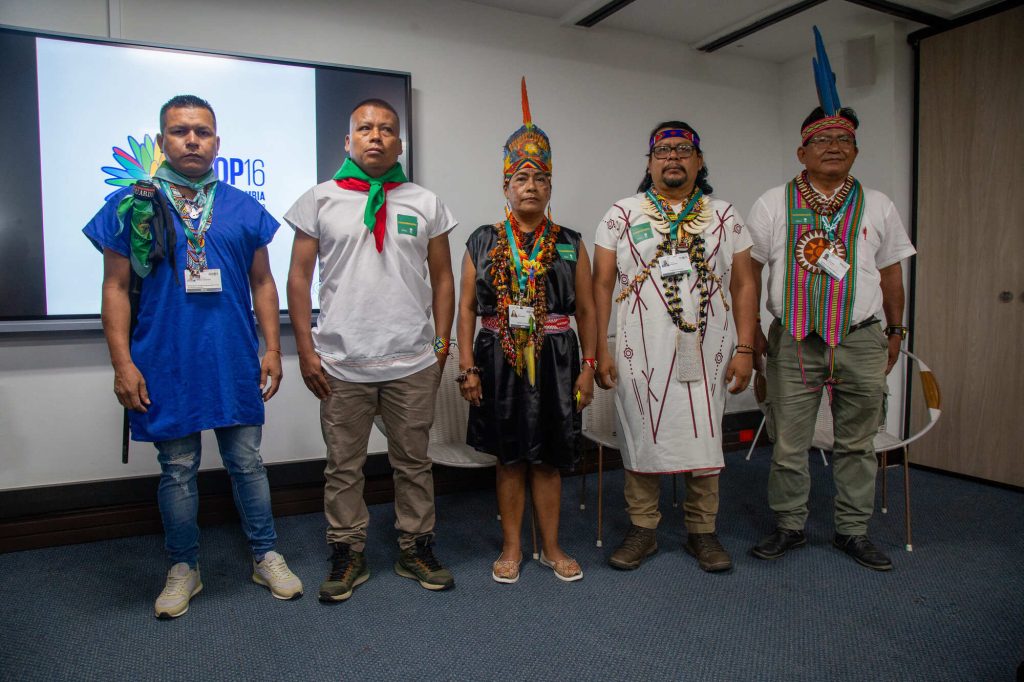
Photo: Ribaldo Piaguaje
The Great Amazonian Maloca according to the cosmogony of the indigenous peoples: spirituality and territorial defense (green zone)
Indigenous social and spiritual dynamics are not only connected to thriving biodiverse forests in their territories, but can be taken as philosophical and practical guidance for Western industrial societies to change their destructive habits of consumption.
Featured speakers included: Justino Piaguaje, Siekopai leader; Mario Erazo Yaiguaje, Siona Leader; Neil Encinas of the Autonomous Territorial Government of the Wampis Nation; Miguel Evanjuanoy and Irma Mojomboy of the Inga people and the Union of Yagéceros Indigenous Doctors of the Colombian Amazon (UMIYAC).

Photo: Ribaldo Piaguaje
Recovering and healing Indigenous territories for the protection of life: Indigenous self-determination in the face of dispossession through state conservation initiatives (green zone)
In South America, many national parks are superimposed over Indigenous lands, many of which were unilaterally declared by States without prior consultation or consent. Across the upper Amazon, Indigenous peoples are fighting to recover their ancestral lands through strategic litigation, mapping, storytelling, and on-the-ground organizing. Legal security and titling of Indigenous territories is essential to enable and strengthen territorial governance and the exercise of self-determination of Indigenous peoples over their ancestral territories; in addition to guaranteeing their physical and cultural survival and effectively combating deforestation and the destruction of biodiversity in the world.
Featured speakers included: Leonidas Iza, president of CONAIE; Camilo Huamoñi, territorial leader of CONFENIAE; Marisol Garcia of the Federation of Kechwa Chazuta Indigenous Peoples of Amazonia (FEPIKECHA); Justino Piaguaje, Siekopai Leader; Samuel Pinedo of the Kechwa People of San Martín; Elisa Marchi, professor at the University of Arizona and former advisor to the United Nations Rapporteur for Indigenous Peoples.
Additionally, we participated in events organized by other groups that explored the link between biodiversity protection and the impacts of climate change, such as the first public hearing of the Global Parliamentary Inquiry on the progress of phasing out fossil fuels in the Amazon, hosted by the Global Network of Parliamentarians for a Fossil Fuel-Free Future (PFFF). This event highlighted the urgent need for a moratorium on extractive activities to safeguard biodiversity, while also addressing the impacts of armed conflict and organized crime, as well as the risks posed to the lives and safety of leaders and defenders.
We also participated in the talk “Lessons and ideas for cultural resilience and the protection of biodiversity in Indigenous territories using digital tools” organized by our long-time allies Awana Digital, in which we shared our experiences on combining ancestral knowledge and technology for the defense of Indigenous territories.
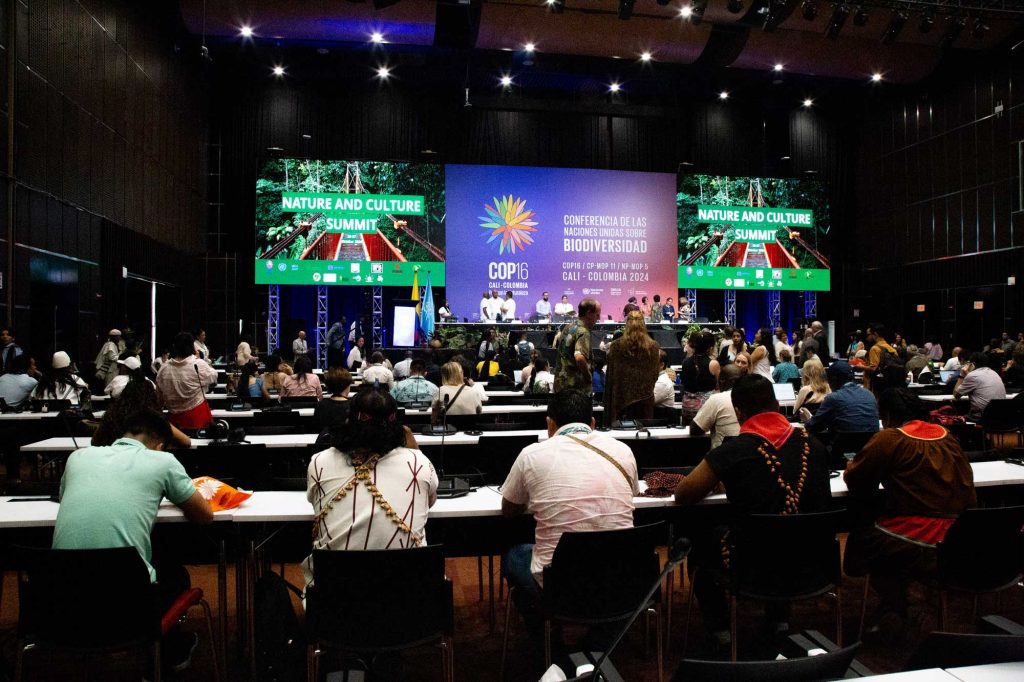
Members of Amazon Frontlines and Ceibo Alliance’s Indigenous delegation participate in the COP16 Nature and Culture Summit. Photo: Ribaldo Piaguaje
Advances and Shortcomings of COP16
As COP16 came to a close on November 1, 2024, significant announcements were made regarding discussions around Article 8J, highlighting the role of Indigenous territories as protected areas essential for the preservation of biodiversity. Additionally, the creation of a subsidiary body was proposed to facilitate collaboration between Indigenous peoples and state governments on the actions and goals of the Convention.
However, critical challenges remain. Firstly, there must be improvements in the levels of Indigenous participation, influence, and, most importantly, decision-making on issues concerning territories, moving beyond decisions that are unilaterally controlled by state governments. Secondly, more effective dialogue is needed between international organizations, the Convention’s secretariat, and Indigenous communities and nations, ensuring periodic and comprehensive monitoring of progress and setbacks occurring daily in the territories.
The structural framework of COP also remained unchanged from previous years. The “Blue Zone” felt remote and inaccessible rather than inclusive, making it challenging for voices from Indigenous territories to be heard. Achieving true participatory inclusion in decision-making spaces remains a distant goal, as these spaces continue to be dominated solely by state government representatives using technical language. Consequently, the rights, autonomy, self-determination, and vital interests of Indigenous peoples within their territories continue to be overlooked.

Photo: Ribaldo Piaguaje
As Siekopai leader Justino Piaguaje says, “The spaces of Indigenous peoples and countries’ delegates cannot be parallel, they must be unified. The world needs to understand that Indigenous territories are vital for biodiversity conservation because of Indigenous people’s leadership. Our way of life, our spirituality, and our forms of governance are what keep forests standing and biodiversity thriving. We are not just caring for and protecting nature, there is real interdependence between nature, our cultures, and societies, and ways of life, and this is what the global community needs to understand in order to restore balance in the world.”
Overall, the summit fell short of achieving the progress needed to reverse biodiversity loss. Ultimately, agreements were drafted and decisions were made without listening to Indigenous peoples. As A’i Cofan leader Alexandra Narvaez says, “People travel from far away to come here and talk about biodiversity and Indigenous territories without including us in the conversation. And they make decisions they don’t fulfill.” Amazon Frontlines lawyer and human rights defender, Jorge Acero, adds: “there’s still a crucial battle ahead to guarantee the inclusion of Indigenous values, voices, and proposals in these global decision-making spaces.”
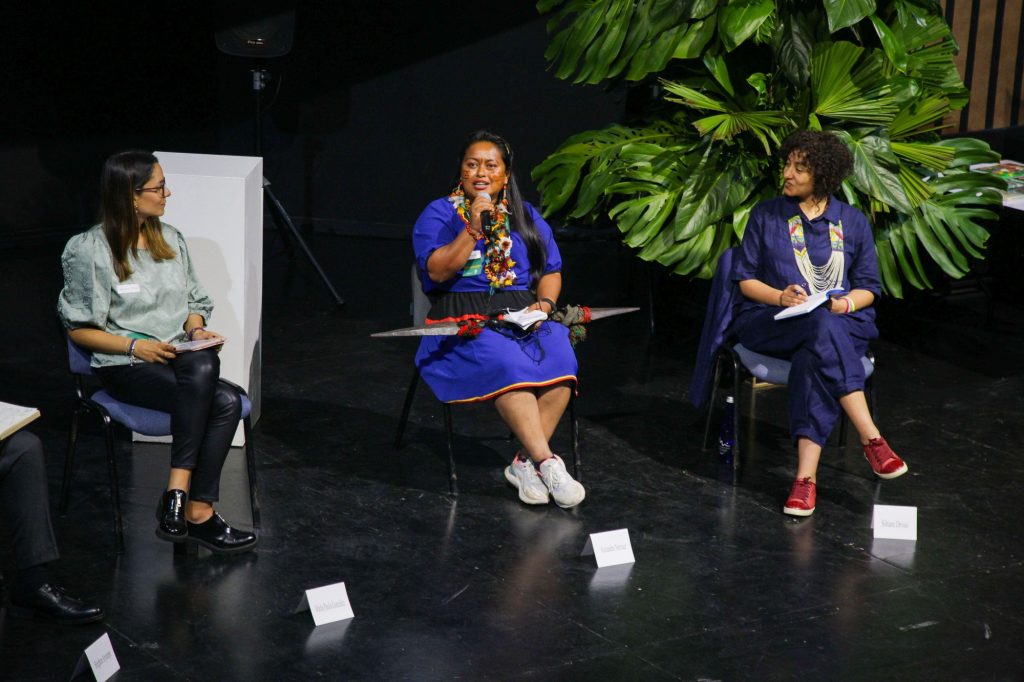
A’i Cofán Leader Alexandra Narvaez speaks at the Global Witness event “Closing the gap: Promoting an enabling environment for environmental defenders advancing biodiversity and climate justice” Photo: Ribaldo Piaguaje
Here are our takeaways on the COP16’s critical shortcomings:
- States have made little progress in recognizing Indigenous territories as legitimate forms of conservation or in including them as indicators of compliance with the Global Framework. This failure allows States to perpetuate a colonial and racist approach to conservation, focused on the creation of protected areas or national parks that frequently violate Indigenous rights. It fundamentally overlooks Indigenous land tenure, ownership, governance, and ways of life—essential elements for the effective protection and conservation of biodiversity within these territories.
- There was no discussion of the link between climate change and biodiversity, nor was there any mention of deforestation due to extractive activities, the destruction caused by armed conflict, and the lack of protections for indigenous peoples living on borders.
- There was no agreement on financing mechanisms that would provide Indigenous peoples with direct access to funds.
- The largest polluting states—primarily China, the United States, India, the European Union, and Russia—refused to intensify their efforts to protect biodiversity.
- A logic of nature’s commodification persists, often at the expense of Indigenous peoples who live in harmony with the environment. Despite the clear connections between fossil fuel extraction, biodiversity loss, and the violation of Indigenous rights, the elimination of fossil extraction was excluded from the final text of the negotiations.
As a global community, we are failing to confront the crisis of mass extinctions, which is deeply intertwined with the crises of deforestation, climate change, attacks on territorial defenders, the loss of Indigenous territories, and the erosion of Indigenous cultural and territorial autonomy. Despite the failures of international diplomacy and the image-laundering tactics of governments and corporations, those of us on the frontlines must continue to resist. We must revitalize ancestral knowledge, strengthen Indigenous guardianship, and support Indigenous leaders to engage in international spaces, challenging the narratives that legitimize and obscure violence.
Written by Amazon Frontlines & Ceibo Alliance’s COP16 delegation of Iand and rights defenders


